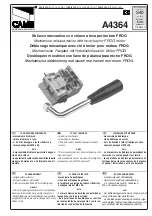
16 ENGLISH
Lighting up the front lamp
►
Fig.4:
1.
Lamp
CAUTION:
Do not look in the light or see the
source of light directly.
Pull the switch trigger to light up the lamp. The lamp
keeps on lighting while the switch trigger is being pulled.
The lamp goes out approximately 10 seconds after
releasing the switch trigger.
CAUTION:
If the lamp goes off after blinking
for a few seconds, the active feedback sensing
technology is not working properly. Ask your
local Makita Service Center for repair.
NOTE:
Use a dry cloth to wipe the dirt off the lens of
the lamp. Be careful not to scratch the lens of lamp, or
it may lower the illumination.
NOTE:
The front lamp cannot be used while the dust
collection system (optional accessory) is installed in
the tool.
Reversing switch action
►
Fig.5:
1.
Reversing switch lever
CAUTION:
Always check the direction of
rotation before operation.
CAUTION:
Use the reversing switch only after
the tool comes to a complete stop.
Changing the
direction of rotation before the tool stops may dam-
age the tool.
CAUTION:
When not operating the tool,
always set the reversing switch lever to the neu-
tral position.
This tool has a reversing switch to change the direction
of rotation. Depress the reversing switch lever from the
A side for clockwise rotation or from the B side for coun-
terclockwise rotation.
When the reversing switch lever is in the neutral posi-
tion, the switch trigger cannot be pulled.
Selecting the action mode
NOTICE:
Do not rotate the action mode chang-
ing knob when the tool is running.
The tool will be
damaged.
NOTICE:
To avoid rapid wear on the mode
change mechanism, be sure that the action mode
changing knob is always positively located in one
of the three action mode positions.
Rotation with hammering
For drilling in concrete, masonry, etc., turn the action
mode changing knob to the
symbol while pressing
the release button on the knob. Use a tungstencarbide
tipped bit (optional accessory).
►
Fig.6:
1.
Rotation with hammering
2.
Action mode
changing knob
3.
Release button
Rotation only
For drilling in wood, metal or plastic materials, turn the action
mode changing knob to the symbol while pressing the
release button on the knob. Use a twist drill bit or wood drill bit.
►
Fig.7:
1.
Rotation only
Hammering only
For chipping, scaling or demolition operations, turn
the action mode changing knob to the symbol while
pressing the release button on the knob. Use a bull
point, cold chisel, scaling chisel, etc.
►
Fig.8:
1.
Hammering only
Hook
Optional accessory
CAUTION:
Always remove the battery when
hanging the tool with the hook.
CAUTION:
Never hook the tool at high loca-
tion or on potentially unstable surface.
The hook is convenient for temporarily hanging the tool.
Before installing the hook, remove the rubber cap from
the screw holes in the mounting bracket. Insert the plate
washers under the bracket, and then tighten the hook
with screws in place.
►
Fig.9:
1.
Rubber cap
2.
Mounting bracket
3.
Plate
washers
4.
Hook
5.
Screws
For use, lift up the arm of the hook until it snaps into the
open position.
When not in use, be sure that the hook is folded back in
the closed position.
►
Fig.10:
1.
Hook
2.
Open position
3.
Closed position
►
Fig.11
Connecting lanyard (tether strap) to
the hook
CAUTION:
Do not use damaged hook and
screws. Before use, always check for damages,
cracks or deformations, and make sure that the
screws are tightened.
CAUTION:
Make sure that the hook is
securely installed with the screws.
CAUTION:
Do not install or remove any
accessory while hanging the tool.
The tool may fall
if the screws are not tightened.
CAUTION:
Always use a locking carabiner
(multi-action and screw gate type) and be sure
to attach the lanyard (tether strap) to the double
looped portion of the hook.
Improper attachment
may cause tool drop from the hook and result in
personal injury.
The hook is also used for connecting the lanyard (tether
strap). Be sure to connect the lanyard (tether strap) to
the double looped portion of the hook.
►
Fig.12:
1.
Double looped portion of the hook
2.
Lanyard (tether strap)
3.
Locking cara-
biner (multi-action and screw gate type)
Summary of Contents for 0088381754781
Page 2: ...2 1 1 2 3 Fig 1 1 2 Fig 2 1 Fig 3 1 Fig 4 1 A B Fig 5 1 2 3 3 Fig 6 1 Fig 7 ...
Page 3: ...3 1 Fig 8 1 2 3 5 4 Fig 9 1 2 3 Fig 10 Fig 11 1 2 3 Fig 12 1 2 3 4 5 Fig 13 ...
Page 4: ...4 1 2 Fig 14 1 2 Fig 15 1 2 Fig 16 1 2 Fig 17 1 2 Fig 18 1 2 5 4 3 Fig 19 1 2 Fig 20 ...
Page 5: ...5 2 1 3 Fig 21 1 2 Fig 22 1 2 Fig 23 1 2 3 4 Fig 24 1 3 2 Fig 25 1 2 Fig 26 1 Fig 27 ...
Page 6: ...6 1 2 3 4 Fig 28 1 Fig 29 1 2 Fig 30 1 Fig 31 1 2 Fig 32 1 2 3 4 5 Fig 33 Fig 34 Fig 35 ...
Page 7: ...7 Fig 36 1 2 Fig 37 1 2 Fig 38 1 Fig 39 1 2 Fig 40 Fig 41 Fig 42 Fig 43 ...
Page 8: ...8 Fig 44 1 Fig 45 4 1 2 3 Fig 46 1 2 3 Fig 47 1 Fig 48 1 2 1 2 Fig 49 Fig 50 ...
Page 9: ...9 1 Fig 51 1 2 Fig 52 1 Fig 53 1 Fig 54 1 2 1 2 Fig 55 1 Fig 56 ...
Page 174: ...174 ...
Page 175: ...175 ...
















































